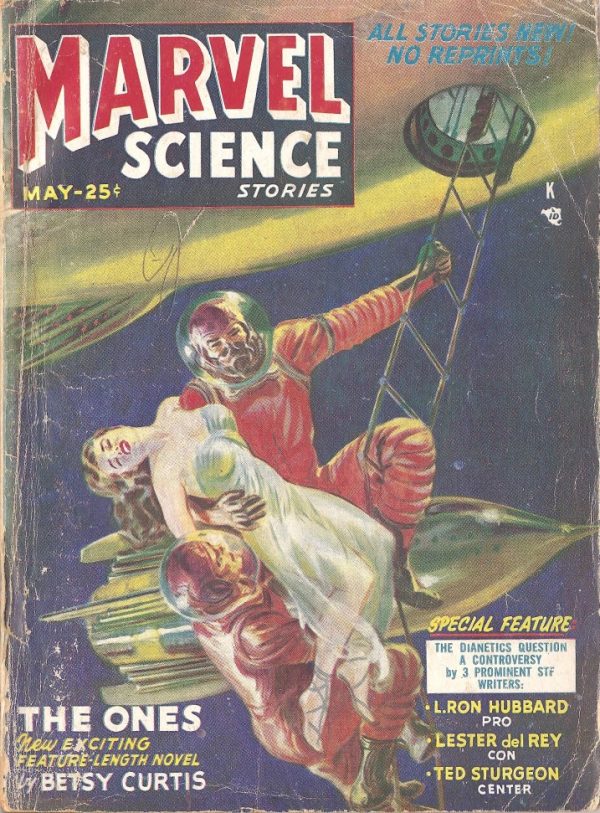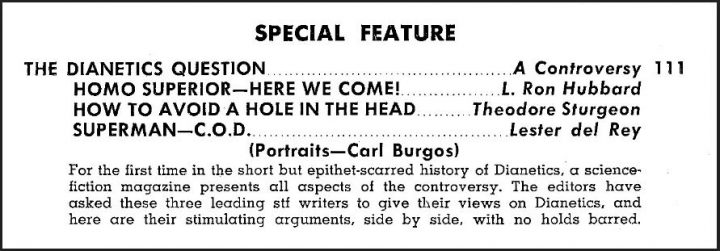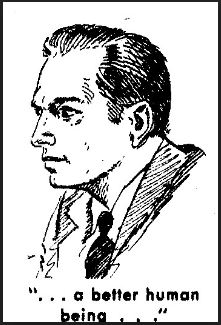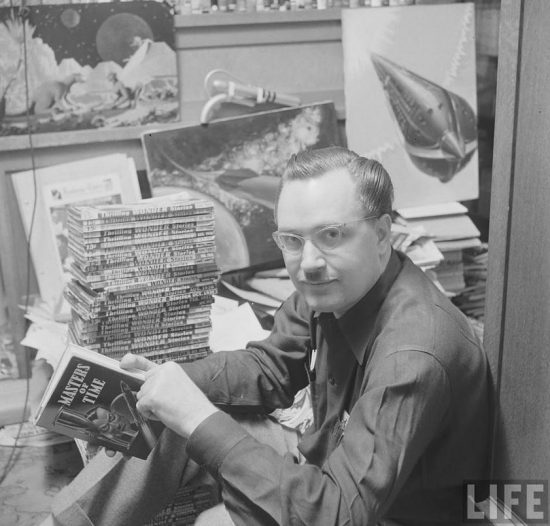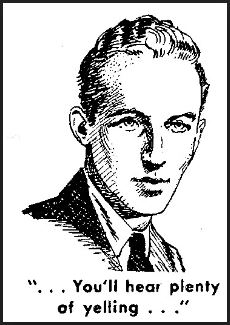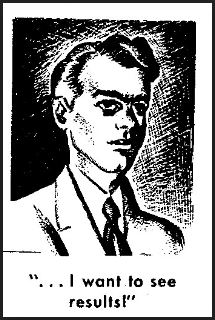Underground Bunker reader Once Born, who runs the always informative blog, Scientology Books and Media, got his hands on a fascinating 1951 issue Marvel Science Stories that contains a three-part debate over Dianetics, L. Ron Hubbard’s invention that had been released the year before. In this piece, being released simultaneously here and at his blog, Once Born goes through the magazine debate, which featured Hubbard himself.
The Marvel Science Stories that we’re looking at today came out in May 1951 — one year after the first article describing “Dianetics” appeared in Astounding Science Fiction. During this time, the editor of Astounding, John W Campbell (initially an enthusiastic convert) had promoted Dianetics for all he was worth.
However, by March 1951 the Dianetics fad had run its course in Astounding (you can follow the rise and fall of Dianetics in Astounding here).
Marvel took this opportunity to capitalize on the interest in the subject by publishing this written debate between Hubbard and two prominent science fiction authors, Theodore Sturgeon and Lester del Rey. Hubbard didn’t get the easy ride he’d received from Campbell. Although Sturgeon rather sat on the fence, he was far from enthusiastic, and del Rey dismissed Dianetics as absurd pseudoscience.
This kind of thing had been published before. The author James Blish had given a generally favorable assessment of Dianetics in another pulp SF magazine, Planet Stories, in November 1950 – only six months after its introduction. However, by May 1951, when Marvel joined the fray, the SF community seems to have tired of the hype surrounding Dianetics. They were apparently prepared to kick Hubbard a bit, while he was down.
Here’s how the “debate” was presented:
Let’s examine them in that order.
Homo Superior – Here We Come! (L Ron Hubbard)
Hubbard opens with a convoluted anecdote which deploys his two favourite tactics – presenting a scare story about controversial aspects of psychiatry, and making unsupported claims about the efficacy of Dianetics.
He describes a girl who was supposedly…
Being carefully observed in a state mental institution after a long series of electric shocks, and her doctor was on the point of deciding that there was no more hope for her to completely recover, and no hope for getting her out of the hospital except through a pre-frontal lobotomy.
Today, this girl is living a normal life with her family. She has just successfully completed a business course [and] has secured a job […].
This is dianetics at work. The two persons who have worked with this girl had no previous training in mental therapy, and used only dianetic processing.
Needless to say, absolutely no evidence for these claims is presented. Hubbard does say that “The Hubbard Dianetic Research Foundation is preparing evidential material that will soon be published” – however, nothing convincing ever appeared.
He continues to his real pitch – selling Dianetics as self-improvement. He describes someone who is, as a result of studying the subject, “far more dynamic, and yet makes fewer people angry. He is a better human being.” That’s a bit of a come-down from those wild medical claims.
Hubbard is clearly peeved by Lester del Rey’s article (which he has seen in advance) but he answers none of its criticisms. Instead, he attacks del Rey himself – and uses Dianetics to do so:
The viciousness of Mr. del Rey’s attack displays so clearly the abberative force behind it, that no defence on this matter should be necessary.
In other words: ‘Dianetics is valid because it shows that my critics are irrational for opposing it. The only sane people are those who accept Dianetics.’ There’s a circular argument.
Hubbard’s reasoning goes downhill from there. Del Rey is charged with arguing that the “common sense” of laymen is inferior to qualified medical opinion (huh?) and his opponent is condemning Dianetics only because he has not practised nor understood it.
Hubbard closes with some very questionable “proof” of the efficacy of Dianetics – a long quote from his own literary agent, the flamboyant Forrest J. Ackerman (incidentally misspelling Ackerman’s first name with only one ‘r’).
Perhaps what follows was actually Hubbard writing in Ackerman’s name. Perhaps not. Either way, it is unconvincing. For a start, Ackerman has a vested financial interest in Hubbard’s literary success.
Ackerman presents Hubbard’s best fiction as if this supported his claims to have invented a new science. Sorry Forry – that just doesn’t follow.
It’s interesting that Ackerman dials Hubbard’s hype back a little – but his claims for the state of Clear are still remarkable. He assures us that Clears have no psychiatric problems, need only four hours sleep a night, and not only recall but also re-experience everything that has happened to them in this and previous lives with photographic clarity.
For anyone who wants to actually see a clear, Ackerman explains that one of their talents is the ability to avoid attention. After all…
…’normal’ people would want to poke at them and probe, 25 hours a day, demanding “What tricks can you do? Prove to me that you’re a clear!”
Finally, Ackerman assures us that he and 6,000 other people in LA have seen a clear in the person of Sonya Bianca. He evidently did not know that her presentation in the Shrine Auditorium in August 1950 as ‘The World’s First Clear’ was a humiliating calamity for Hubbard (or perhaps Hubbard, hoping that word had not got around, was going here for a big bluff).
Bianca certainly did not demonstrate her photographic memory. When questions were invited, a member of the audience, having heard Bianca was studying physics, asked her to recall a simple formula. She couldn’t. Neither could she remember the color of Hubbard’s tie when his back was turned.
The audience laughed and jeered at Hubbard, then left. SF writers and fans were starting to do the same.
How To Avoid a Hole in the Head (Theodore Sturgeon)
Theodore Sturgeon was the model for the Author Kurt Vonnegut’s fictional science-fiction writer Kilgore Trout. In Vonnegut’s early novel, God Bless You Mr Rosewater he observed of Trout, “His prose was frightful. Only his ideas were good.” That’s a fair criticism of Sturgeon. However, people didn’t read pulp science fiction to learn about perfect literary form – they wanted novel, interesting ideas and a sense of wonder with their adventure stories. Sturgeon was very good at this.
One of his best novels is Some of Your Blood. It’s a psychological horror story with a happy ending. The therapist who brings that happy ending about was probably modeled on an (infeasibly effective) practitioner of Dianetics.
In “How to Avoide a Hole in the Head,” Sturgeon opens with the observation that the subject of Dianetics polarises opinion and makes a plea for “general openmindedness and progressive thought [rather] than a rundown of Dianetics” (presumably he means ‘rather than running Dianetics down’).
He’s not initially concerned with the truth or falsehood of Hubbard’s creation, but offers both sides of the argument some advice about conducting a civilized debate instead.
For example, he advises those who “Are agin it” to, “read the more understandable parts of the (acutely badly-written book) […] and then try the therapy yourself before you start shooting your mouth off.” Back in 1951 this was a reasonable point – although some would argue that the ‘theory’ of Dianetics was so incoherent and unsupported that objectively testing it was hardly worth the effort.
In passing, we should note that Sturgeon was supposed to be the “Middle of the Road” commentator, and calling Dianetics “acutely badly-written” was not a good start for Hubbard.
Sturgeon also advise opponents to “stop making such a fuss” about the similarity between Freudian ideas of the unconscious and Hubbard’s reactive mind. In doing so, he inadvertently highlights the fact that Dianetics is mostly plagiarised psychoanalysis.
Some of his advice to supporters of Dianetics is still valid today. For example, “Only a fool will accept the whole because he finds one or two of its parts acceptable.” Also, his observation that blind faith is dangerous and Hubbard is not the messiah.
Unfortunately he then goes and spoils it all by observing that “Dianetics, for all its effectiveness is not a panacea” and “Don’t get so cocky as you acquire experience in auditing that think you can throw the ground rules out.” All you can say to this, many years later is “show me the evidence for the effectiveness of Dianetics.” In fact, this is precisely what the next author, Lester Del Rey, does say.
Superman – COD (Lester del Rey)
Today, Lester del Rey is remembered more for his work as an editor and publisher than for his fiction.
When pulp magazines started to give way to radio and television, science fiction was one of the few genres which made the transition to book publishing. Authors gradually commanded better wages and had more time to polish their work – with the help of good editors like Del Rey – leading to science fiction with real literary quality.
His lasting legacy is probably his work editing del Ray books, with his wife, Judy-Lynn del Rey.
In “Superman – COD,” del Rey goes straight for the throat, comparing what he sees as one of the appeals of Dianetics – namely, “The secret feeling that you’re basically superior to your fellow man” – with that of racism. He expands on this by explaining the popularity of Hubbard’s book as due to the fact that, “It gives the credulous reason to believe that he can really be the superman he always felt he was.”
As he continues, you wonder if del Rey isn’t getting in a subtle personal dig at Hubbard.
[Dianetics] purports to be a science, which is the current catch-word to replace the older black-magic in the popular mind. The fact that it lacks a fundamental scientific basis has little to do with the average, untrained reader’s idea that he is being scientific in trying out the “Experiments” – totally without controls or any basis of objective evaluation – in the book.
There’s a valid criticism regarding scientific method – something Hubbard never understood. The reference to confusing science with magic is also fascinating, and still relevant today. However, you have to wonder if del Rey had heard rumours of Hubbard’s strange activities with the pioneering rocket scientist and occultist Jack Parsons, and was taunting him. Hubbard’s peevish article certainly suggests that del Rey had hit a number of nerves.
Del Rey then proceeds to take Dianetics apart, starting with Hubbard’s misuse of the term ‘axiom’ and ‘theory’ and moving on from there. He even attacks Hubbard’s great revelation…
The dynamic principle of existence is SURVIVE according to him. Sheer gobbledegook. The principle of living is living! Or, if he means the “dynamic principle is the desire or struggle to survive – another thing – it sounds good, but it is a long way from certain.
Lester del Rey is one of the first to state that Hubbard’s writing often looks as if it makes sense, but dissolves into meaningless ambiguity the moment you inspect it closely – you are constantly left asking, “what does that even mean?” He won’t be the last.
Del Rey’s most damning criticism (which he pursues at great length) is the total lack of evidence for any of Hubbard’s many and various claims on behalf of Dianetics.
There are all kinds of statements about demonstrable proof – but when we get done with the book, all we have is Hubbard’s word and the injunction to go out and try the therapy….True, he does give some rather interesting and sex-sadistic little stories as case histories, but they have about as much relation to case histories as the Doc Methuselah stories do.
For all his skepticism, del Rey tried hard to meet a “Clear,” with no success. He observes, “Supposedly there are 270 such people. That should be enough to interest scientific investigation.” Then he ridicules Sturgeon’s weak notion that Clears conceal themselves so as not to bothered by the curiosity of we mere mortals.
All del Rey wants is to see results and not studies undertaken “by men who have a major stake in seeing Dianetics accepted.” He points out that the officers of the tax exempt ‘Dianetics Research Foundation’ (including Hubbard) can “draw any salary they choose of themselves [and] arrange for a life-time, handsome source of income.”
That must have irked Hubbard too. The Dianetics Foundations were getting into financial difficulties precisely because he had been too greedy, drawing too much money out for himself, and killing the Goose that was laying his golden eggs. Dianetics would file for bankruptcy eight months later, in February 1952.
Del Rey closes by demolishing Hubbard’s peevish contention that he did not respect the common sense of the ordinary people who supported Dianetics.
Common-sense indicated that Dianetics is much too risky for its use generally, or for a parlour game. After all, if the common judgement had been used as a test, morphine would have accepted as a remarkable cure-all, second only to heroin.
Game, set, and match.
— Once Born
——————–
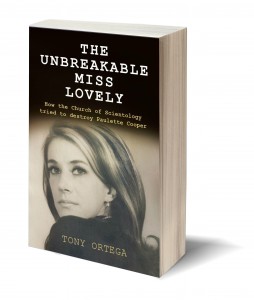 Posted by Tony Ortega on August 16, 2016 at 07:00
Posted by Tony Ortega on August 16, 2016 at 07:00
E-mail tips and story ideas to tonyo94 AT gmail DOT com or follow us on Twitter. We post behind-the-scenes updates at our Facebook author page. After every new story we send out an alert to our e-mail list and our FB page.
Our book, The Unbreakable Miss Lovely: How the Church of Scientology tried to destroy Paulette Cooper, is on sale at Amazon in paperback and Kindle editions. We’ve posted photographs of Paulette and scenes from her life at a separate location. Reader Sookie put together a complete index. More information about the book, and our 2015 book tour, can also be found at the book’s dedicated page.
Learn about Scientology with our numerous series with experts…
BLOGGING DIANETICS: We read Scientology’s founding text cover to cover with the help of L.A. attorney and former church member Vance Woodward
UP THE BRIDGE: Claire Headley and Bruce Hines train us as Scientologists
GETTING OUR ETHICS IN: Jefferson Hawkins explains Scientology’s system of justice
SCIENTOLOGY MYTHBUSTING: Historian Jon Atack discusses key Scientology concepts
Other links: Shelly Miscavige, ten years gone | The Lisa McPherson story told in real time | The Cathriona White stories | The Leah Remini ‘Knowledge Reports’ | Hear audio of a Scientology excommunication | Scientology’s little day care of horrors | Whatever happened to Steve Fishman? | Felony charges for Scientology’s drug rehab scam | Why Scientology digs bomb-proof vaults in the desert | PZ Myers reads L. Ron Hubbard’s “A History of Man” | Scientology’s Master Spies | Scientology’s Private Dancer | The mystery of the richest Scientologist and his wayward sons | Scientology’s shocking mistreatment of the mentally ill | Scientology boasts about assistance from Google | The Underground Bunker’s Official Theme Song | The Underground Bunker FAQ
Our Guide to Alex Gibney’s film ‘Going Clear,’ and our pages about its principal figures…
Jason Beghe | Tom DeVocht | Sara Goldberg | Paul Haggis | Mark “Marty” Rathbun | Mike Rinder | Spanky Taylor | Hana Whitfield





